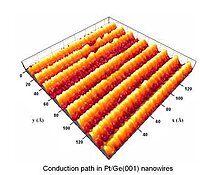Self-Organized Atomic Nanowires and Charge Density Waves
A fascinating realization of quasi-one-dimensional systems are self-organized atomic nanowires on semiconductor surfaces. At room temperature, they usually show metallic behavior, yet when cooled they can exhibit a charge density wave. This effect results from the specific Fermi surface of quasi-1D systems. It implies a metal-insulator transition, which in the electronic structure becomes visible as energy gap. It also leads to a periodic superstructure of the atomic chains. These phenomena can be accessed directly with angle-resolved photoelectron spectroscopy (ARPES) and scanning tunneling microscopy (STM). Such structures can e.g. be generated by In-, Pt- or Au-Atoms on Si and Ge surfaces. A special subset are terraced high-index surfaces, where the lateral spacing of the nanowires can be controlled. A key advantage of 1D surface structures is the ability to directly influence the experimental parameters, such as substrate geometry and adatom valence (ranging from d- to s-character).
In addition, there are indications that some atomic chains are stable against CDW formation down to rather low temperature. Here an opportunity emerges to perform spectroscopic studies of deviations from the Fermi liquid behavior. The separate dispersion of the spin- and charge degrees of freedom (spin-charge separation) is a robust criterion on the energy scale of the band width, which is accessible by ARPES. This aspect closely relates to model descriptions from solid state theory.


